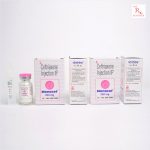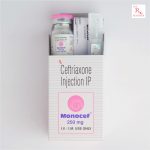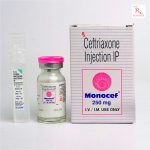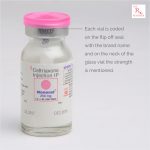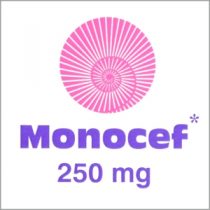
| Dosage | : | Injection |
| Contains | : | Ceftriaxone sodium IP equivalent to Ceftriaxone 250 mg injection |
| Category | : | Antibiotics |
| Uses | : | Bacterial infections |
| Price | : | Rs. 25.94 |
Monocef contains Ceftriaxone, a 3rd Generation Cephalosporin and is a leading wide spectrum antibiotic.
It was launched by Aristo Pharmaceuticals Pvt. Ltd. in the year 1989 and today, is the No. 1 prescribed injectable antibiotic brand in India. It is also the Top 5th brand of the Indian Pharmaceutical Market with a 41% market share of the Ceftriaxone segment.
Manufacturing of Monocef complies with the requirements of Indian and International Pharmacopoeia. It is manufactured in a PLC controlled, linear integration process which provides Zero Human Touch that significantly minimizes the risk of external contamination. Each vial is coded on the flip off seal with the brand name and on the neck of the glass vial, the strength is mentioned.
Monocef is used and administered in the treatment of both gram -ve and gram +ve bacterial infections.
Active Ingredients & Packaging
Ceftriaxone sodium IP equivalent to Ceftriaxone 250 mg injection
Marketing & Manufacturing
Marketed by: Aristo Pharmaceuticals Pvt. Ltd.
Address: 23 A, Shah Industrial Estate, Off Veera Desai Rd, Andheri West, Mumbai, Maharashtra 400053.
Manufactured by: Aristo Pharmaceuticals Pvt. Ltd.
Address: Hill Top Industrial Estate, Jharmajiri, EPIP Phase 1 (Extn.), Bhatoli Kalan, Baddi, Dist. Solan, Himachal Pradesh – 173205, India.
Price
MONOCEF INJ 250 mg: Rs. 25.94
Other Variants
Monocef is used in the management of:
MENINGITIS caused by Haemophilus influenzae, Neisseria meningitidis or Streptococcus pneumonia.
INTRA-ABDOMINAL INFECTIONS caused by Escherichia coli, Klebsiella pneumoniae, and Bacteroides fragilis
URINARY TRACT INFECTIONS (complicated and uncomplicated) caused by Escherichia coli, Proteus mirabilis, Proteus vulgaris, Morganella morganii or Klebsiella pneumonia
UNCOMPLICATED GONORRHEA (cervical/urethral and rectal) caused by Neisseria gonorrhoeae
PELVIC INFLAMMATORY DISEASE caused by Neisseria gonorrhoeae
SKIN AND SKIN STRUCTURE INFECTIONS caused by Staphylococcus aureus, Staphylococcus epidermidis, Streptococcus pyogenes, Viridans group streptococci and Escherichia coli
Other indications are: Acute Undifferentiated Fever (Auf), Community-Acquired Pneumonia, Brain Abscess, Suppurative Intracranial Infections and Spinal Epidural Abscess.
Safety
Consult your Physician to know more.
Monocef is a Schedule H drug and has to be prescribed by a registered medical practitioner only.
Dosage
INFANTS AND CHILDREN:
For the treatment of skin and skin structure infections, the recommended total daily dose is 50 to 75 mg/kg given once a day (or in equally divided doses twice a day). The total daily dose should not exceed 2 grams.
For the treatment of acute bacterial otitis media, a single intramuscular dose of 50 mg/kg (not to exceed 1 gram) is recommended.
For the treatment of serious miscellaneous infections other than meningitis, the recommended total daily dose is 50 to 75 mg/kg, given in divided doses every 12 hours.
The total daily dose should not exceed 2 grams.
In the treatment of meningitis, it is recommended that the initial therapeutic dose be 100 mg/kg (not to exceed 4 grams). Thereafter, a total daily dose of 100 mg/kg/day (not to exceed 4 grams daily) is recommended. The daily dose may be administered once a day (or in equally divided doses every 12 hours). The usual duration of therapy is 7 to 14 days.
Method of Usage
Intramuscular Administration: Reconstitute Ceftriaxone powder with the appropriate diluent (see COMPATIBILITY AND STABILITY). Inject diluent into vial, shake vial thoroughly to form solution. Withdraw entire contents of vial into syringe to equal total labeled dose.
After reconstitution, each 1 mL of solution contains approximately 250 mg equivalent of Ceftriaxone according to the amount of diluent indicated below. If required, more dilute solutions could be utilized.
As with all intramuscular preparations, Ceftriaxone should be injected well within the body of a relatively large muscle; aspiration helps to avoid unintentional injection into a blood vessel.
Reconstitution of vial:
Vial Dosage Size 250 mg: Amount of Diluent to be added ( 250 mg/ml) is 0.9 mL
Intravenous Administration: Ceftriaxone should be administered intravenously by infusion over a period of 30 minutes, except in neonates where administration over 60 minutes is recommended to reduce the risk of bilirubin encephalopathy. Concentrations between 10 mg/mL and 40 mg/mL are recommended; however, lower concentrations may be used if desired. Reconstitute vials with an appropriate IV diluent. (see COMPATIBILITY AND STABILITY).
Reconstitution of vial:
Vial Dosage Size 250 mg: Amount of Diluent to be added ( 250 mg/ml) is 2.4 mL
After reconstitution, each 1 mL of solution contains approximately 100 mg equivalent of Ceftriaxone. Withdraw entire contents and dilute to the desired concentration with the appropriate IV diluent.
Administration
Ceftriaxone may be administered intravenously or intramuscularly. Do not use diluents containing calcium, such as Ringer’s solution or Hartmann’s solution, to reconstitute Ceftriaxone vials or to further dilute a reconstituted vial for IV administration because a precipitate can form. Precipitation of Ceftriaxone-calcium can also occur when Ceftriaxone is mixed with calcium-containing solutions in the same IV administration line.
Ceftriaxone must not be administered simultaneously with calcium-containing IV solutions, including continuous calcium-containing infusions such as parenteral nutrition via a Y-site. However, in patients other than neonates, Ceftriaxone and calcium-containing solutions may be administered sequentially of one another if the infusion lines are thoroughly flushed between infusions with a compatible fluid.
There have been no reports of an interaction between Ceftriaxone and oral calcium-containing products or interaction between intramuscular Ceftriaxone and calcium-containing products (IV or oral).
Neonates: Hyperbilirubinemic neonates, especially prematures, should not be treated with Ceftriaxone.
Ceftriazone is contraindicated in premature neonates: Ceftriaxone is contraindicated in neonates (≤ 28 days) if they require (or are expected to require) treatment with calcium-containing IV solutions, including continuous calcium-containing infusions such as parenteral nutrition because of the risk of precipitation of Ceftriaxone-calcium.
Intravenous doses should be given over 60 minutes in neonates to reduce the risk of bilirubin encephalopathy.
Adverse Reactions/ Side Effects
Ceftriaxone is generally well tolerated. In clinical trials, the following adverse reactions, which were considered to be related to Ceftriaxone therapy or of uncertain etiology, were observed:
Local Reactions – pain, induration and tenderness was 1% overall. Phlebitis was reported in <1% after IV administration. The incidence of warmth, tightness or induration was 17% (3/17) after IM administration of 350 mg/mL and 5% (1/20) after IM administration of 250 mg/mL.
General Disorders and Administration Site Conditions – injection site pain (0.6%).
Hypersensitivity – rash (1.7%). Less frequently reported (<1%) were pruritus, fever or chills.
Infections & Infestations – genital fungal infection (0.1%). Hematologic – eosinophilia (6%), thrombocytosis (5.1%) and leukopenia (2.1%). Less frequently reported (<1%) were anemia, hemolytic anemia, neutropenia, lymphopenia, thrombocytopenia and prolongation of the prothrombin time.
Gastrointestinal – diarrhea/loose stools (2.7%). Less frequently reported (<1%) were nausea or vomiting, and dysgeusia. The onset of pseudomembranous colitis symptoms may occur during or after antibacterial treatment.
Hepatic – elevations of AST (3.1%) or ALT (3.3%). Less frequently reported (<1%) were elevations of alkaline phosphatase and bilirubin.
Renal – elevations of the BUN (1.2%). Less frequently reported (<1%) were elevations of creatinine and the presence of casts in the urine.
Central nervous system – headache or dizziness were reported occasionally (<1%).
Genitourinary – moniliasis or vaginitis were reported occasionally (<1%).
Miscellaneous – diaphoresis and flushing were reported occasionally (<1%).
Investigations – blood creatinine increased (0.6%).
Other rarely observed adverse reactions (< 0.1%) include abdominal pain, agranulocytosis, allergic pneumonitis, anaphylaxis, basophilia, biliary lithiasis, bronchospasm, colitis, dyspepsia, epistaxis, flatulence, gallbladder sludge, glycosuria, hematuria, jaundice, leukocytosis, lymphocytosis, monocytosis, nephrolithiasis, palpitations, a decrease in the prothrombin time, renal precipitations, seizures, and serum sickness.
Warnings and Precautions
Hypersensitivity
Before therapy with Cetriaxone is instituted, careful inquiry should be made to determine whether the patient has had previous hypersensitivity reactions to cephalosporins, penicillin, Beta Lactam agents or other drugs.
This product should be given cautiously to penicillin and other beta-lactam agent sensitive patients. Antibacterial drugs should be administered with caution to any patient who has demonstrated some form of allergy, particularly to drugs. Serious acute hypersensitivity reactions may require the use of subcutaneous epinephrine and other emergency measures.
As with all beta-lactam antibacterial agents, serious and occasionally fatal hypersensitivity reactions (i.e. anaphylaxis) have been reported. In case of severe hypersensitivity reactions, treatment with Ceftriaxone must be discontinued immediately and adequate emergency measures must be initiated.
Interaction with Calcium – Containing Products
Do not use diluents containing calcium, such as Ringer’s solution or Hartmann’s solution, to reconstitute Ceftriaxone vials or to further dilute a reconstituted vial for IV administration because a precipitate can form. Precipitation of Ceftriaxone-calcium can also occur when Ceftriaxone is mixed with calcium-containing solutions in the same IV administration line. Ceftriaxone must not be administered simultaneously with calcium-containing IV solutions, including continuous calcium-containing infusions such as parenteral nutrition via a Y-site. However, in patients other than neonates, Ceftriaxone and calcium-containing solutions may be administered sequentially of one another if the infusion lines are thoroughly flushed between infusions with a compatible fluid. In vitro studies using adult and neonatal plasma from umbilical cord blood demonstrated that neonates have an increased risk of precipitation of Ceftriaxone-calcium.
Clostridium difficile – Associated Diarrhea
Clostridium difficile associated diarrhea (CDAD) has been reported with use of nearly all antibacterial agents, including Ceftriaxone, and may range in severity from mild diarrhea to fatal colitis. Treatment with antibacterial agents alters the normal flora of the colon leading to overgrowth of C. difficile.
- difficile produces toxins A and B which contribute to the development of CDAD. Hypertoxin producing strains of C. difficile cause increased morbidity and mortality, as these infections can be refractory to antimicrobial therapy and may require colectomy. CDAD must be considered in all patients who present with diarrhea following antibiotic use. Careful medical history is necessary since CDAD has been reported to occur over two months after the administration of antibacterial agents.
If CDAD is suspected or confirmed, ongoing antibiotic use not directed against C. difficile may need to be discontinued. Appropriate fluid and electrolyte management, protein supplementation, antibiotic treatment against C. difficile, and surgical evaluation should be instituted as clinically indicated.
Hemolytic Anemia
An immune mediated hemolytic anemia has been observed in patients receiving cephalosporin class antibacterials including Ceftriaxone. Severe cases of hemolytic anemia, including fatalities, have been reported during treatment in both adults and children. If a patient develops anemia while on Ceftriaxone, the diagnosis of a cephalosporin associated anemia should be considered and Ceftriaxone should be stopped until the etiology is determined.
Development of Drug-resistant Bacteria
Prescribing Ceftriaxone in the absence of a proven or strongly suspected bacterial infection or a prophylactic indication is unlikely to provide benefit to the patient and increases the risk of the development of drug-resistant bacteria. Prolonged use of Ceftriaxone may result in overgrowth of non-susceptible organisms. Careful observation of the patient is essential. If super-infection occurs during therapy, appropriate measures should be taken.
Patients with Renal or Hepatic Impairment
Ceftriaxone is excreted both by biliary & renal route. The dosage adjustment in renal impairment patients is not needed for usual dosages of Ceftriaxone.
Dosage adjustments should not be necessary in patients with hepatic dysfunction; however, in patients with both hepatic dysfunction and significant renal disease, caution should be exercised and the Ceftriaxone dosage should not exceed 2 gm daily.
Ceftriaxone is not removed by peritoneal- or hemodialysis. In patients undergoing dialysis no additional supplementary dosing is required following the dialysis. In patients with both severe renal and hepatic dysfunction, close clinical monitoring for safety and efficacy is advised.
Effect on Prothrombin Time
Alterations in prothrombin times have occurred in patients treated with Ceftriaxone. Monitor prothrombin time during Ceftriaxone treatment in patients with impaired vitamin K synthesis or low vitamin K stores (eg, chronic hepatic disease and malnutrition). Vitamin K administration (10 mg weekly) may be necessary if the prothrombin time is prolonged before or during therapy.
Concomitant use of Ceftriaxone with Vitamin K antagonists may increase the risk of bleeding. Coagulation parameters should be monitored frequently, and the dose of the anticoagulant adjusted accordingly, both during and after treatment with Ceftriaxone.
Gallbladder Pseudolithiasis
Ceftriaxone-calcium precipitates in the gallbladder have been observed in patients receiving Ceftriaxone. These precipitates appear on sonography as an echo without acoustical shadowing suggesting sludge or as an echo with acoustical shadowing which may be misinterpreted as gallstones. The probability of such precipitates appears to be greatest in pediatric patients. Patients may be asymptomatic or may develop symptoms of gallbladder disease. The condition appears to be reversible upon discontinuation of Ceftriaxone sodium and institution of conservative management. Discontinue Ceftriaxone sodium in patients who develop signs and symptoms suggestive of gallbladder disease and/or the sonographic findings described above.
Urolithiasis and Post-Renal Acute Renal Failure
Ceftriaxone-calcium precipitates in the urinary tract have been observed in patients receiving Ceftriaxone and may be detected as sonographic abnormalities. The probability of such precipitates appears to be greatest in pediatric patients. Patients may be asymptomatic or may develop symptoms of urolithiasis, and ureteral obstruction and post-renal acute renal failure. The condition appears to be reversible upon discontinuation of Ceftriaxone sodium and institution of appropriate management. Ensure adequate hydration in patients receiving Ceftriaxone. Discontinue Ceftriaxone in patients who develop signs and symptoms suggestive of urolithiasis, oliguria or renal failure and/or the sonographic findings described above.
Pancreatitis
Cases of pancreatitis, possibly secondary to biliary obstruction, have been reported in patients treated with Ceftriaxone. Most patients presented with risk factors for biliary stasis and biliary sludge (preceding major therapy, severe illness, total parenteral nutrition).
Carcinogenesis
Considering the maximum duration of treatment and the class of the compound, carcinogenicity studies with Ceftriaxone in animals have not been performed. The maximum duration of animal toxicity studies was 6 months.
Mutagenesis
Genetic toxicology tests included the Ames test, a micronucleus test and a test for chromosomal aberrations in human lymphocytes cultured in vitro with Ceftriaxone. Ceftriaxone showed no potential for mutagenic activity in these studies.
Impairment of Fertility
Ceftriaxone produced no impairment of fertility when given intravenously to rats at daily doses up to 586 mg/kg/day, approximately 20 times the recommended clinical dose of 2 g/day.
Contraindications
Hypersensitivity
Ceftriaxone is contraindicated in patients with known hypersensitivity to Ceftriaxone, any of its excipients or to any other cephalosporin. Patients with previous hypersensitivity reactions to penicillin and other beta lactam antibacterial agents may be at greater risk of hypersensitivity to Ceftriaxone.
Premature Neonates
Ceftriaxone is contraindicated in premature neonates up to a post-menstrual age of 41 weeks (gestational age + chronological age).
Hyperbilirubinemic Neonates
Hyperbilirubinemic neonates should not be treated with Ceftriaxone. Ceftriaxone can displace bilirubin from its binding to serum albumin, leading to a risk of bilirubin encephalopathy in these patients.
Neonates Requiring Calcium Containing IV Solutions
Ceftriaxone is contraindicated in neonates ( ≤ 28 days) if they require (or are expected to require) treatment with calcium-containing IV solutions, including continuous calcium-containing infusions such as parenteral nutrition because of the risk of precipitation of Ceftriaxone-calcium.
Cases of fatal outcomes in which a crystalline material was observed in the lungs and kidneys at autopsy have been reported in neonates receiving Ceftriaxone and calcium-containing fluids.
In some of these cases, the same intravenous infusion line was used for both Ceftriaxone and calcium-containing fluids and in some a precipitate was observed in the intravenous infusion line. There have been no similar reports in patients other than neonates.
Lidocaine
Intravenous administration of Ceftriaxone solutions containing lidocaine is contraindicated. When lidocaine solution is used as a solvent with Ceftriaxone for intramuscular injection, exclude all contraindications to lidocaine.
Drug Interactions
Consult your Physician to know more.
Overdosage
In the case of over dosage, drug concentration would not be reduced by hemodialysis or peritoneal dialysis. There is no specific antidote. Treatment of over dosage should be symptomatic.
Storage
N/A
Disclaimer
Data is provided by Aristo Pharmaceuticals Pvt. Ltd.
References
- NHS Choices. What should I do if I miss a dose of antibiotics? – Accessed: June 14, 2018.
- Ever Miss a Dose of Your Medicine? – Accessed: June 14, 2018.
- Net (2014). The Importance of Taking Your Medication Correctly – Accessed: June 14, 2018.
- Schachter, S.C., Shafer, P. O. &; Sirven, J.I. (2013). Missed Medicines. Epilepsy Foundation – Accessed: June 14, 2018.
- National Institute of Drug Abuse (2010). Prescription Drugs: Abuse and Addiction. Report Research Series – Accessed: July 21, 2016.
- eMedicinehealth (2016). Drug Overdose Overview – Accessed: June 14, 2018.
- Centers for Disease Control and Prevention (2010). Unintentional drug poisoning in the United States – Accessed: June 14, 2018.
- Centers for Disease Control and Prevention. December 12, 2011. Put your medicines up and away and out of sight – Accessed: June 14, 2018.
- The Center for Improving Medication Management and the National Council on Patient Information and Education. The quick scoop: medicines and your family: safely storing and disposing of medicines – Accessed: June 10, 2016.
- S. Food and Drug Administration. December 24, 2013. How to dispose of unused medications – Accessed: June 14, 2018.
- World Health Organization: Information sheet: Pharmaceuticals in drinking-water – Accessed: July 1, 2016.
- Lyon, R. C., Taylor, J. S., Porter, D. A., et al. (2006) Stability profiles of drug products extended beyond labeled expiration dates. Journal of Pharmaceutical Sciences; 95:1549-60 – Accessed: June 14, 2018.
- Harvard Medical School (2016). Drug Expiration Dates – Do They Mean Anything? – Accessed: June 14, 2018.





